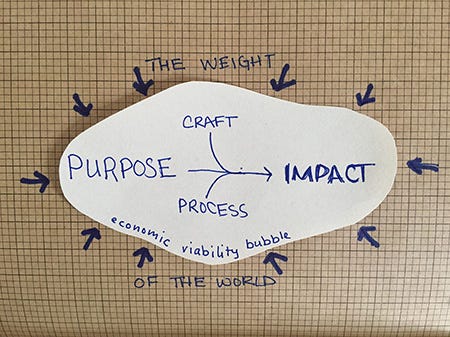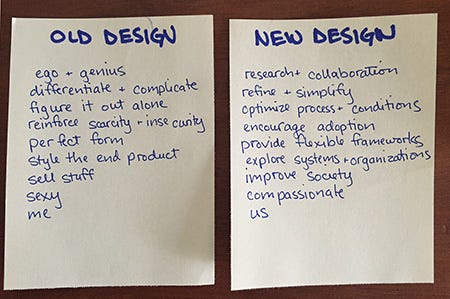I came to The Conference in Malmö, Sweden as a user experience designer in transition and found it not just inspiring but profound and moving, even tearing up a few times. This past year I’ve been following a a few vague, disparate leads looking for a more holistic vision of design which amazingly materialized at this one gathering. It felt like thee new new and the most interesting potential future to be a part of.

This is the first time I’ve seen ethical and effective approaches to design practice considered at all levels — from macro-economic systems, business and organizational structure, through the design process, down to UI executions and employee support. I’m not sure the word design quite covers it. There were ethnographers, journalists, chefs, researchers and artists working in a range of environments — as solo practitioners, within large corporations, at universities, and at small agencies and collectives. The Conference is not a design conference per se but aims to “explore complexity and trends in the digital world”. There is no defined medium, discipline or industry since it depends on the problem — many of which require multiple platforms and connections between organizations and silos. It’s more a sensibility, materializing based on the focus of the practitioner. Projects have the scale and complexity common in the tech/startup world without the hyper-capitalism (Uber for social infrastructure!) There’s the sophistication, innovation, and high visual/production value commonly reserved for customer-facing corporations and luxury markets, but with the goal of creating a better society.
We have been in huge transition in recent years where the rules for a digital world are being figured out. Should all innovation be in service of financial growth with core services controlled by corporate entities? Or can more be in the hands of citizens? How to we deal with wealth inequality, climate change and systemic bias and polarization? What is the future of labor and is it inherently at odds with technology?

This vague new world has been percolating for a while and has become more conspicuous over the past few years. Architects seem more common in the space than visual designers, perhaps more experienced with scale, complexity, systems and public process. As a young graphic designer with a lifelong interest in social justice, I was inspired by the First Things First Manifesto revival in 1999, but became a bit cynical by the time ‘design for good’ came up via a SxSW keynote by Designers Accord 10 years later. Accessible examples and opportunities have always been elusive. Who are the clients for such work? How is it funded? Do they even value design? How do you go from studying typography at art school to building infrastructure in Africa? It seems a bit involved to just be a hobby for dilettantes. The limited discourse there proved to be thin on entry points, models, and logistics. These projects inevitably don’t seem to go very far (the DA speaker/founder moved on to be an SVP at Walmart). So I, as many do, turned to the networks I knew and the employers who were experienced with hiring designers — entertainment, start-ups, digital marketing agencies, etc. But perhaps with the proliferation of user experience and research in tech and the popularity of large-scale service startups, design has a much clearer place in social innovation.
Though I’ve always sought out these ideas, I’ve very rarely seen the level of insight, complexity, competence and commitment I saw at The Conference. The focus wasn’t on the speakers, how important they are, how indispensable their profession is in the abstract. It was specific projects and goals and how to be more effective, ideas to be aware of, common problems and how to overcome them. It was actual practitioners talking about practice.
1-hour-ish sessions consisted of either 1 big keynote or 2 related breakout topics with a couple speakers each. It was a stark contrast to events like SxSW — much more intimate, focused, cohesive and consistent.
The amazing talks I saw on Day 2 include:
Indy Johar: architect, co-founder of Zero Zero (project00.cc)
This barnburner (or barnraiser) of a talk defined the space of civic systemic design covering everything from investment models and methods for gaining public support for civic projects to oblique personal projects like the women who plant food throughout their town in England and open source furniture design with localized CNC production. If you only watch one video this summer, watch this one.
HUMANS, LABOUR AND TECHNOLOGY
Guy Standing: economist and author, University of London
Sha Hwang: information designer, Nava
Standing spoke of the current economic system of rentiers (who collect money on non-work) and the precariat (working class with no stability) and promoted basic income. Hwang, a member of the team that saved Healthcare.gov, explored the infrastructure of protest with the inspiring story of the logistics of the Montgomery bus boycott.
WORMS, SUSTAINABILITY AND INNOVATION
Matt Orlando: owner/chef of AMASS in Copenhagen
Orlando spoke of his obsession with reducing waste in the restaurant industry, sourcing the best local/organic ingredients and starting a kids food education program all while upholding the culinary and customer service standards of a world-class fine dining destination.
BEING AN EMPATHETIC COMPANY
Leah Reich: Senior User Researcher, Slack
Lain Shakespeare: Corporate Citizenship Manager, Mailchimp
Reich spoke about empathy on a personal level within a company’s work culture, addressing hypocrisy and common misunderstandings. Shakespeare spoke of more effective and meaningful CSR by partnering with local organizations instead of the same old big ones.
ONLINE HARASSMENT
Caroline Sinders: designer
Michelle Mederos: product designer, Facebook
Sinders identified the pervasive harrassment problems on Twitter as a design issue, not about society or free speech, and offered some simple UI solutions. Mederos spoke of a breakthrough in approach in addressing imposter accounts (common in India to humiliate women) intervening before the problem started and not forcing the victim to anxiously deal with it after the fact.
Angela Oguntala: Futures Consultant
Oguntala spoke of the importance of imagining a future in order to work toward it as visions can be very powerful (at this vantage, Minority Report seemed a bit quaint and wristwatch phones seemed downright silly). Notably, she had an example of the practical application of speculative design which I’ve never quite understood the context for.
I unfortunately missed most of Day 1, but caught these great talks so far online:
Tricia Wang: tech ethnographer, Constellate Data
Wang explored a history of bias that still exists even in our new technologies like VR, big data and machine learning. She showed examples and implications as well as the importance of seeking out different perspectives first hand.
Clive Thompson: Journalist
Thompson discussed how kids use Minecraft and the importance of buggy open playgrounds to get kids to understand how digital experiences and social rules are built. They are then better prepared to build and critique the technology of the future, not become helplessly dependent on slick, closed systems. This was especially resonant to me as a parent of a young child with a budding interest in Minecraft (which I have had little patience for since it’s pretty weird to use). As a UX designer I know how much is hidden from users in the effort to reduce friction and have been leery of too much digital exposure for my child without a clear understanding of underlying concepts.
So there it is. All that in an old slaughterhouse in my dad’s home town filled good vegan snacks, conceptual installations, and cheerful helpers in white overalls. After the conference they had a recessional, same song as my wedding — a conference after my own heart! What’s next after such an event? I don’t know yet, but having an alternate hi-rez vision of the future is a good start.
No comments yet.